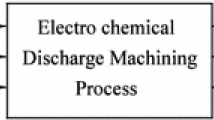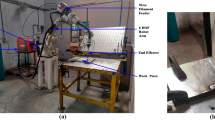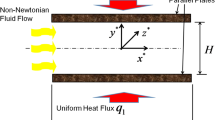Abstract
Input-output relationships of tungsten inert gas (TIG) welding and abrasive flow machining (AFM) processes were determined using radial basis function networks (RBFNs). A batch mode of training was adopted to implement the principle of back-propagation (BP) algorithm (which works based on a steepest descent algorithm) and a genetic algorithm (GA), separately. The performances of RBFN tuned by a BP algorithm and that trained by a GA were compared, on some test cases related to the above two manufacturing processes. The GA-optimized RBFN was found to perform slightly better than the BP-tuned RBFN. The back-propagation algorithm works based on the principle of a steepest descent method, whose solutions have the chance of getting stuck at the local minima, whereas the probability of the GA-solutions for being trapped at the local minima is less. However, their performances may depend on the nature of the deviation (error) function.
Similar content being viewed by others
References
Rosenthal D (1941) Mathematical theory of heat distribution during welding and cutting. Weld J 20(5):220–234
Roberts DK, Wells AA (1954) Fusion welding of aluminimum alloys. Br Weld J 12:553–559
Yang LJ, Chandel RS, Bibby MJ (1993) An analysis of curvilinear regression equations for modeling the submerged arc welding process. J Mater Process Technol 37(1–4):601–611
Murugan N, Parmer RS, Sud SK (1993) Effect of submerged arc process variables on dilution and bead geometry in single wire surfacing. J Mater Process Technol 37:767–780
Lee JI, Rhee S (2000) Prediction of process parameters for gas metal arc welding by multiple regression analysis. Proc Inst Mech Eng B 214:443–449
Kim IS, Son JS, Kim IG, Kim JY, Kim OS (2003) A study on relationship between process variables and bead penetration for robotic Co2 arc welding. J Mater Process Technol 136:139–145
Anderson K, Cook GE, Ramaswamy K (1990) Artificial neural network applied to arc welding process modeling and control. IEEE Trans Ind Appl 26(5):824–830
Cook GE, Barnett RJ, Anderson K, Strauss AM (1995) Weld modeling and control using artificial neural networks. IEEE Trans Ind Appl 31(6):1484–1491
Nagesh DS, Datta GL (2002) Prediction of weld bead geometry and penetration in shielded metal-arc welding using artificial neural networks. J Mater Process Technol 123:303–312
Juang SC, Tarng YS, Lii HR (1998) A comparison between the back-propagation and counter-propagation networks in the modeling of the TIG welding process. J Mater Process Technol 75:54–62
Jain VK, Adsul SG (2000) Experimental investigations into abrasive flow machining. Int J Mach Tools Manuf 40(7):1003–1021
Jain RK, Jain VK (2000) Optimum selection of machining conditions in abrasive flow machining using neural networks. J Mater Process Technol 108(1):62–67
Smith AE, Slaughter WS (1997) Neural network modeling of abrasive flow machining. Proc. of the Advanced Technology Program Motor Vehicle Manufacturing Technology Public Workshop, NIST Document, NISTIR 6079, Ann Arbor, MI, pp 151–158, October
Rivas VM, Merelo JJ, Castillo PA, Arenas MG, Castellano JG (2004) Evolving RBF neural networks for time-series forecasting with EVRBF. Inf Sci 165:207–220
Broomhead DS, Lowe D (1988) Multivariable functional interpolation and adaptive networks. Complex Syst 11:321–355
Moody JE, Darken C (1989) Fast learning in networks of locally tuned processing units. Neural Comput 2(1):281–294
Chen S, Cowan CF, Grant PM (1991) Orthogonal least squares algorithm for learning radial basis function networks. IEEE Trans Neural Netw 2(2):302–309
Chen S, Chng ES, Alkadhimi K (1996) Regularized orthogonal least squares algorithm for constructing radial basis function networks. Int J Control 64(5):829–837
Leonardis A, Bischof H (1998) An efficient MDL-based construction of RBF networks. Neural Netw 11:963–973
Holland J (1975) Adaptation in natural and artificial systems. The Univ. of Michigan Press, Ann Arbor
Billings SA, Zheng GL (1995) Radial basis function network configuration using genetic algorithms. Neural Netw 8(6):877–890
Sheta AF, de Jong K (2001) Time-series forecasting using GA-tuned radial basis functions. Inf Sci 133(3–4):221–228
Ganjigatti JP (2006) Application of Statistical Methods and Fuzzy Logic Techniques to Predict Bead Geometry in Welding. Ph.D. thesis, IIT Kharagpur, India
Author information
Authors and Affiliations
Corresponding author
Rights and permissions
About this article
Cite this article
Mollah, A.A., Pratihar, D.K. Modeling of TIG welding and abrasive flow machining processes using radial basis function networks. Int J Adv Manuf Technol 37, 937–952 (2008). https://doi.org/10.1007/s00170-007-1026-8
Received:
Accepted:
Published:
Issue Date:
DOI: https://doi.org/10.1007/s00170-007-1026-8




